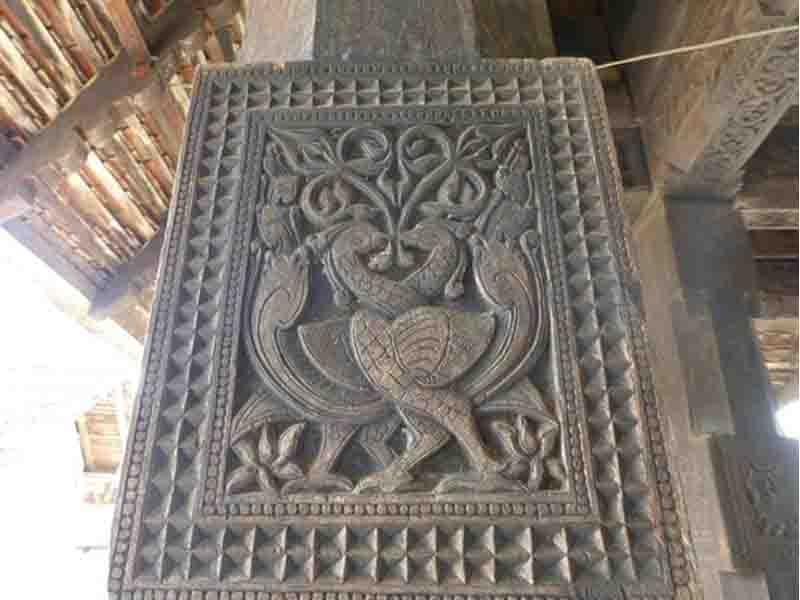Embekke Devale

Embekke Devale, famed for its elaborate woodcarvings, pillars and other structures, nestle in the Udu Nuwara. It lies close to Daulagala about eight miles from Kandy. Enticing Wood carvings - The UNESCO has identified these marvellous but elaborate carvings on wooden pillars to be the finest products of woodcarvings to be found in any part of the world. Many are the hoary legends that tell of the origins of this splendid devale. According to archaic documents and the epic Embekke Varnanawa composed by Delgahagoda Mudiyanse, it was built during the Gampola period of King Wickrema Bahu II (1371 AD). One of his consorts named Henakanda Biso Bandara, in association with a drummer named as Rangama, as told in a miraculous dream, is supposed to have built this Devale dedicated to God Kataragama in a superb three-storeyed building which is now no more. The devale is in two segmented buildings, the Digge (Dancing Hall) and Drummers Hall (Hewasi Mandappaya). Among them that caught my fascination are the following ones. The wooden capital pillars have assumed varied shapes moulded skilfully into these intricate wood carvings. The bottom square is octagonal with carvings, while its top terminates in a leaf emanating from square. The other intricate but unique piece of woodcarvings rest on the Pecada. Enticing woodcarvings are also carved on some beams, rafters, doorways, and doors as well. Among the best masterpieces on the capital pillars are thus: Hansa Puttuwa (entwined swans) double headed eagles, and entwined rope designs, mother breast-feeding child, soldier fighting on horseback, female dancing figures, wrestlers, women emanating from a vein, bird with human figure, combination of elephant-bull and combination of elephant-lion. Among such wonderful carvings, what attracted me most was the elephant-bull carving and that of the elephant with its elongated trunk which is mystically manifested. When one covers with one's palm, the figure of the carving resembling part bull, the real figure of the elephant with elongated trunk is manifested, while when one does the same with that of the elephant there emerges like magic the figure of the bull! The roof of the Embekke Devale bears some ingenuous revelations of classic carpentry masterpieces in fixing the rafters. The 'Madol Kurupuwa' is one of the finest examples of medieval carpentry excellence. It is a wooden pin (this Madol Kurupuwa) which holds together 26 rafters at the hipped end of the roof of the Digge of Embekke Devale. The giant pin is carved with pathuruliya, patha motifs. Embekke ambalama (Ritta Ge) in ruins. The wooden pillars here are replicas of those at the devale. Among the carvings, there are 125 series of decorations, 256 liyawel, 64 lotus designs in Pekada, 30 decorative patterns on timber, roof members, making a total of 514 such exquisite carvings. All's well with the Embekke Devale, except the fact that the parapet wall facing the road unwanted posters have been pasted which is a real eye-sore to the visiting tourists, particularly to foreigners. The caretakers should be alert to prevent such unwarranted posters being pasted on the wall, which would mar this historic site. A little distance away about 1/8 mile lies another assembly of stone pillars on which are carved the very replicas of the wooden pillars of the Embekke Devale. There are altogether 16 numbers of such columns in the base, with two octagonal sections above and square blocks in the centre and the end with carvings on four sides. It is believed that the wooden beams of the roof had rested on carved wooden capitals (Pekada), which are no longer to be seen in the site. The roof had been covered with flat tiles. Rope design, entwining swan, berunde bird, dancing girl are some of the creations found on these stone columns, quite akin to the woodcarvings at Embekke Devale. The villagers still remember the existence of this Ambalama with the wooden roof about 100 years ago. The original state of the roof is shown in a photograph that appeared in Henry Cave's 'Book Of Ceylon' published in 1908. The Ambalama is 27 feet long and 22 feet wide, built on a platform with four monolithic columns in each corner, which is seven feet in height. This building is also called Sinhasana Mandapaya. In ancient times, the king and his royal entourage used to rest here and watch the perahera when it was held. Of these stone pillars about seven have fallen down on the ground, while a few of them are broken into two. The stone carvings on the fallen stone pillars are fast defacing, posing a threat to its carvings. It is worthwhile if the Department of Archaeology takes immediate but concrete steps to have these fallen stone pillars restored to save this great national monument from acts of potential vandalism.
